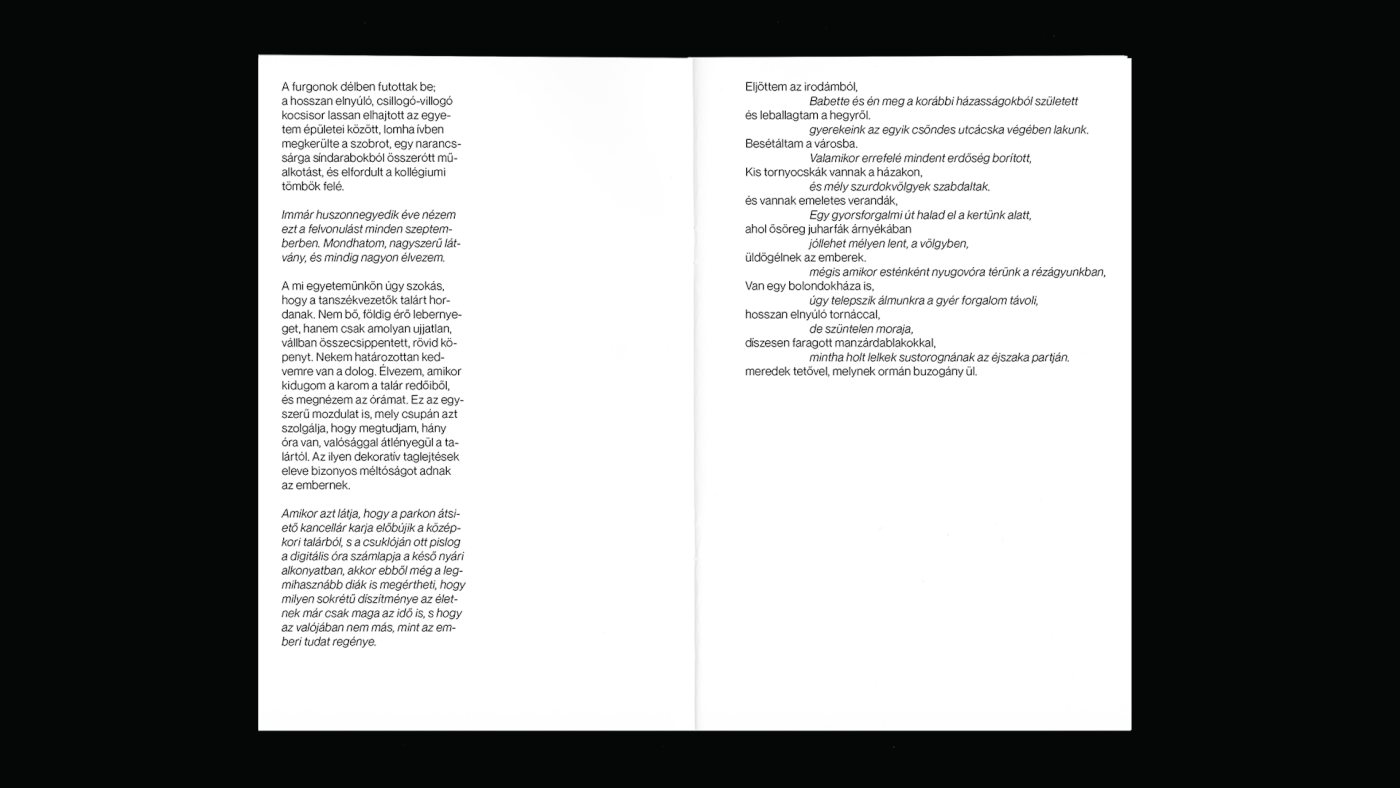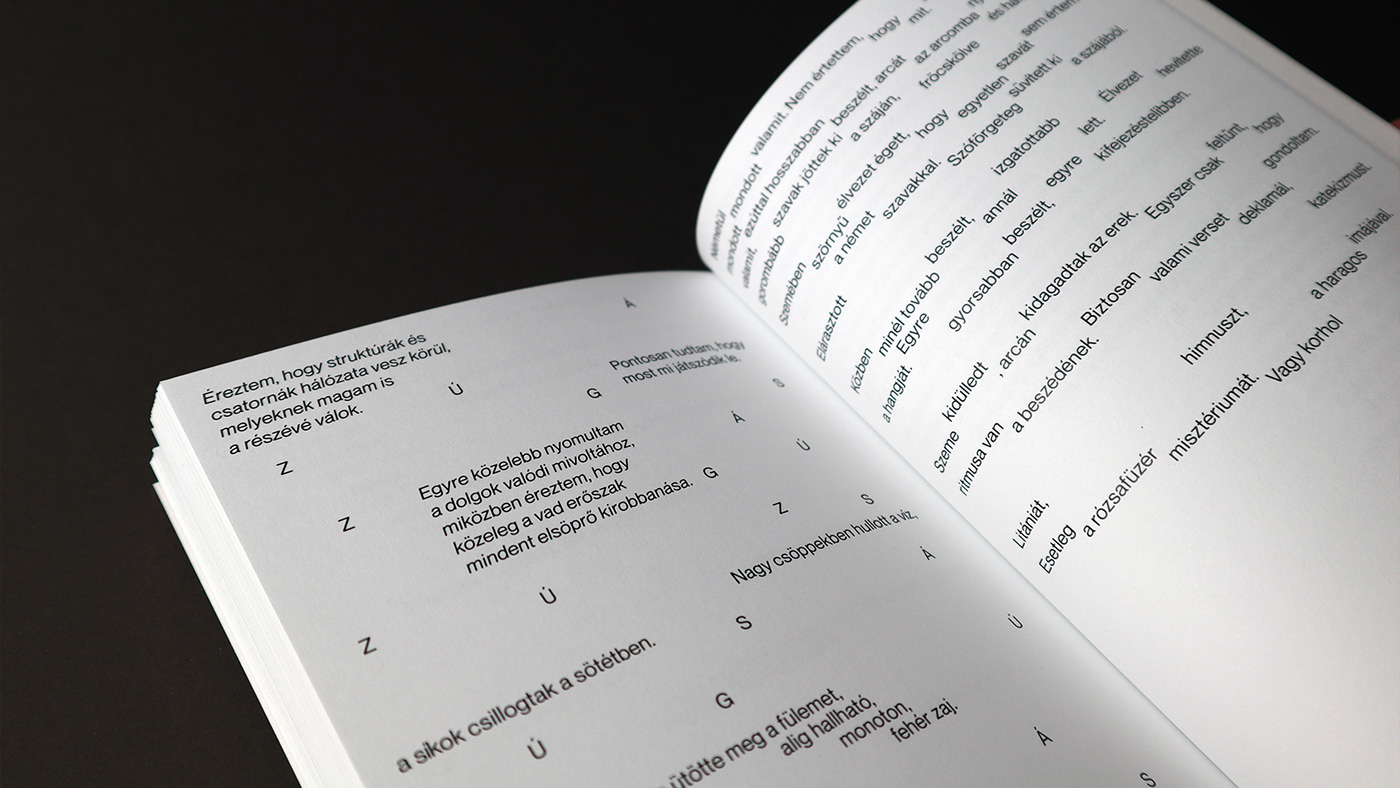
RESONATING STORIES | AN ALTERNATIVE EDITION OF "WHITE NOISE"
• transmedia storytelling, book design
The project is an alternative, experimental edition of Don DeLillo’s novel "White Noise", which creates a multi-sensory experience by interweaving language, code, visual notation, and sound.
Deep reading becomes increasingly difficult in an age where our senses are constantly stimulated. The project aims to redefine the reading experience and reach out to readers who have lost touch with reading.
The alternative edition of the novel opens up the possibility of a personalised and immersive reading experience that goes beyond traditional narrative engagement and storytelling. By merging analogue and digital modes of reading, it creates the possibility for a new kind of reading experience, where surface reading is replaced by deep reading.
The project's experimental nature lies in blending conventional and digital reading modes. The introduction of game-like, interactive elements such as coded puzzles and a visual reader's journal, which generates unique audio representations, reflect the reader's individual interpretation and emotional response to the novel. The interweaving of these elements creates a multi-sensory experience that encourages active participation: the reader experiences the unfolding of the readable text and its complementary content as a reward. The reader is not only the receiver of the reading experience, but also its co-creator, which results in a deeper connection between the reader and the text.
The project has been featured in:
• Designisso article [link]
• Best of MOME '23 (Budapest Design Week)
• "Akkordok" exhibition (MKISZ, Budapest)
• Vienna Art Book Fair, 2023
Project supervisor: Dóra Balla
Sound design: Esteban de la Torre (EJTECH)
Print: EPC Printing Company
Print: EPC Printing Company



The alternative edition of the novel combines analogue and digital ways of reading.
The reader's first encounter is with the analogue, the printed book. At first glance, the printed book has all the usual characteristics of a traditional printed book: it has a coloured dust jacket, a cover, and a rootlet.
The only unusual and undecipherable feature is the coded image on the cover.

The coloured dust jackets were handmade, using a photopolymer plate and debossing technique, with no ink.

As the dust jacket is removed, the book cover reveals nothing; we see the same coded title.

At first glance, neither the dust jacket nor the cover of the book includes the traditional title label.
Actually, the coded marks on the dust jacket and the cover spell "White Noise" in coded typography.
Actually, the coded marks on the dust jacket and the cover spell "White Noise" in coded typography.

The idea of interaction and the game of encoding - decoding is present from the first moment one picks up the printed book.

Upon opening the book, the reader is met with scattered text and excerpts from the novel.

The printed book is an entry point into the narrative world, containing carefully selected excerpts that reflect the main themes of the novel and the characteristics of its narrative language.
At the same time, they reflect on contemporary reading habits: fragmented reading, lack of attention, superficial reading instead of 'deep reading', and 'scanning through' the text instead of reading persistently.

The fragmented nature of the text also reflects the motif of 'white noise', which represents the hustle and bustle
that surrounds the characters in the world of the novel. The motif of 'white noise' also represents the noise of digital technology and the speed of information processing in the modern world.
The novel is characterised by monotonous, superficial dialogue. At the same time, it reflects the experience of the characters
in their search for meaning: their endless quest to see through the noise, to decipher its meaning and message,
to 'learn to listen'. But it remains beyond their reach.



The text of the novel is not presented in its entirety: the book serves as an entry point into the world of the novel.
The fragmented text gives only an impression of the novel's themes and scattered style.
The aim of the printed book is not to reveal the entire text of the novel but to make the reader want to read it
and to spark their curiosity about it.
This is the first step towards the reception and towards a gradual immersion into the narrative world of 'White Noise'.

Between the quotations, scattered throughout the book's pages, are coded puzzles for the reader to solve.
The solved puzzles gradually unravel the text of the novel.

The printed book contains 11 coded puzzles. By solving them, each unlocks a certain number of chapters of the novel at a time.

The coded puzzles use a modular typography, designed specifically for this project.
In the process of designing the coded letters, letters were drawn on a 5x5 grid structure. The letters were then
hidden by marking the negative space of the modular letters with dots. The connection between the dots follows
the lines of the hidden letter. The use of geometric shapes reinforces the code-like nature of the font.

Drawing the letters within a defined module (line 1), marking the intersections on the grid with squares (line 2),
marking the negative space with dots (line 3), and marking the connections between dots (line 4).

Example: letter A
An essential feature of the coded typography is its ability to keep the characteristics of the letters:
re-encoding them in their typographic system and hiding the letters in their negative space.

The decryption key (no. 0) and the first coded puzzle (no. 1), that reveals the first 4 chapters of the book.

Deciphering the coded content is done in the book, analogously, using a pencil and the decryption key (no. 0).

The alternative edition also includes a digital interface, an application designed specifically for the novel.
The previously mentioned coded puzzles connect the analogue and digital interfaces: upon opening the application,
one finds the same coded puzzles as in the book.
The reader is met with a short message and a description of the following steps - solving the coded puzzles continues in the app.

By typing the solution of the puzzle (previously solved in the book) into the app's interface, it reveals 3 to 4 readable chapters, the equivalent of about 30 printed pages. The amount of text unlocked corresponds to contemporary reading habits: it can be read quickly and does not require prolonged reading.
The unlocked chapters are available in the application and can only be read there. Unlike the traditional edition, in this alternative edition, it is on the digital interface where the text of the novel can be read in its entirety.

Readability aspect: the app offers the option of both a light and a dark mode.

Only the unlocked chapters are available to be read in the application. Once the unlocked chapters have been read, the reader is presented with the possibility of solving a new coded puzzle that unlocks the following 3-4 chapters.
The printed book and the digital application are closely linked, and cannot be used without each other. Although the coded puzzles are available on both platforms, the decryption key can only be accessed in the book. Also, the solution to the coded puzzles can only be introduced in the app once the previously revealed chapters have been read.

Within the app, the reader can also keep a visual reader's diary. This is an additional interactive element that actively involves the reader in the reading process. Taking the traditional reader's diary a step further, I have developed a unique method of using images and icons, instead of language and writing, to highlight and mark text passages and the connections between them that stand out to the reader.

The reader can highlight passages of text that they find interesting or relevant to their interpretation of the narrative
and assign icons to them.
The marking happens through the use of a specific set of icons. These icons fall into three categories, based on elements that are present in any narrative text: characters, locations, themes and motifs.
This process encourages close reading, interpretation and conscious following of the story.

Icon set: characters
Similar to the coded typography used for the coded puzzles, the icons of the visual reader's diary are modular signs.
However, they are non-figurative, abstract signs, which open the possibility of incorporating individual meaning, enhance their interpretability and encourage individual interpretation of the story.

Icon set: locations
The meaning of the icons, mixed with the added individual meaning, helps the process of meaning-making. Together, the visual reader's diary and the use of icons to mark connections help readers to make meaningful connections within the narrative.

Icon set: themes and motifs
The resulting icon combinations reflect the reader's individual interpretation and emotional reaction to the novel.
In this way, the non-conscious process of interpretation is revealed, becoming both conscious and visible.

The visual reader's diary aids the reader in exploring layers of meaning and interacting with the narrative world by interpreting it. It provides not only a visual representation of the reader's individual interpretation
but also an audio representation.
The different combinations of icons reflect the mood of the novel and the plot lines and connections that the reader considers relevant, based on subjective interpretation. Each combination of icons creates a unique generative soundtrack.
The soundscape of the generative audio is based on the motif of 'white noise'. Each icon category has its overall specific sound, within which the icons each have their distinctive sounds. Combined, they generate a short soundtrack that can be saved, looped, set to a specific length, and listened to while reading or while getting in the mood to read.
Presentation of the process of decoding, reading, using the visual reader's diary and generating sound, within the app.
The interactive elements, the reader's incentive to take action,
and the short supplementary materials unlocked as rewards encourage playfulness and active involvement.
This type of transmedia storytelling results in a deeper connection between the reader and the text.

Once the unlocked chapters have been read, the reader has to go back to the book to solve the following puzzle that reveals the following chapters. While reading, the reader can continue to mark relevant passages with the help of the visual reader's diary and generate further soundscapes. This cyclical process continues until the novel is read in its entirety. But it is always the reader who decides to take the first step towards immersion.
Progressing through each element of the experimental edition encourages a gradual immersion in the text.
The more steps the reader takes towards exploring the text and uncovering layers of meaning, the more profoundly and personally they can experience it.
Presentation of the soundscape behind the icons: what do individual icons sound like? what do these icons combined sound like?

Structure of the generative audio material in Max/MSP.

The generative audio is not intended to be melodic or pleasant, but to reflect the icons chosen by the reader.













